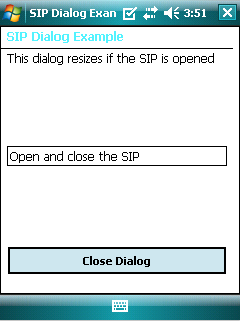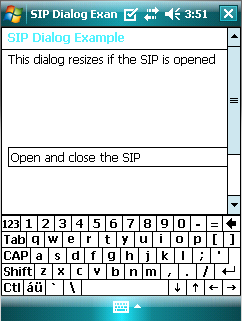
|

|
Sometimes it is necessary for a dialog to take the SIP into account, as the SIP may hide important input widgets. The SIP Dialog Example shows how a
Dialog
对象,
dialog
, can be resized accordingly if the SIP is opened, by embedding the contents of
dialog
在
QScrollArea
.
The
Dialog
类是子类化的
QDialog
that implements a public slot,
desktopResized()
, and a public function,
reactToSIP()
. Also, it holds a private instance of
QRect
,
desktopGeometry
.
class Dialog : public QDialog { Q_OBJECT public: Dialog(); void reactToSIP(); private: QRect desktopGeometry; public slots: void desktopResized(int screen); };
In the constructor of
Dialog
, we start by obtaining the available geometry of the screen with
availableGeometry()
. The parameter used is
0
to indicate that we require the primary screen.
Dialog::Dialog() { desktopGeometry = QApplication::desktop()->availableGeometry(0); setWindowTitle(tr("SIP Dialog Example")); QScrollArea *scrollArea = new QScrollArea(this); QGroupBox *groupBox = new QGroupBox(scrollArea); groupBox->setTitle(tr("SIP Dialog Example")); QGridLayout *gridLayout = new QGridLayout(groupBox); groupBox->setLayout(gridLayout);
We set the window's title to "SIP Dialog Example" and declare a
QScrollArea
对象,
scrollArea
. Next we instantiate a
QGroupBox
,
groupBox
,采用
scrollArea
as its parent. The title of
groupBox
is also set to "SIP Dialog Example". A
QGridLayout
对象,
gridLayout
, is then used as
groupBox
's layout.
创建 QLineEdit , QLabel 和 QPushButton and we set the minimumWidth property to 220 pixels, respectively.
QLineEdit* lineEdit = new QLineEdit(groupBox);
lineEdit->setText(tr("Open and close the SIP"));
lineEdit->setMinimumWidth(220);
QLabel* label = new QLabel(groupBox);
label->setText(tr("This dialog resizes if the SIP is opened"));
label->setMinimumWidth(220);
QPushButton* button = new QPushButton(groupBox);
button->setText(tr("Close Dialog"));
button->setMinimumWidth(220);
Also, all three widgets' text are set accordingly. The
verticalSpacing
property of
gridLayout
is set based on the height of
desktopGeometry
. This is to adapt to the different form factors of Windows Mobile. Then, we add our widgets to the layout.
if (desktopGeometry.height() < 400)
gridLayout->setVerticalSpacing(80);
else
gridLayout->setVerticalSpacing(150);
gridLayout->addWidget(label);
gridLayout->addWidget(lineEdit);
gridLayout->addWidget(button);
The
scrollArea
's widget is set to
groupBox
. We use a
QHBoxLayout
对象,
layout
, to contain
scrollArea
。
Dialog
's layout is set to
layout
and the scroll area's horizontal scroll bar is turned off.
scrollArea->setWidget(groupBox);
QHBoxLayout* layout = new QHBoxLayout();
layout->addWidget(scrollArea);
setLayout(layout);
scrollArea->setHorizontalScrollBarPolicy(Qt::ScrollBarAlwaysOff);
The following signals are connected to their respective slots:
button
's
pressed()
signal to
QApplication
's
closeAllWindows()
slot,
dialog
's
desktopResized()
槽。
connect(button, SIGNAL(clicked()),
qApp, SLOT(closeAllWindows()));
connect(QApplication::desktop(), SIGNAL(workAreaResized(int)),
this, SLOT(desktopResized(int)));
}
The
desktopResized()
function accepts an integer,
screen
, corresponding to the screen's index. We only invoke
reactToSIP()
if
screen
is the primary screen (e.g. index = 0).
void Dialog::desktopResized(int screen) { if (screen != 0) return; reactToSIP(); }
The
reactToSIP()
function resizes
dialog
accordingly if the desktop's available geometry changed vertically, as this change signifies that the SIP may have been opened or closed.
void Dialog::reactToSIP() { QRect availableGeometry = QApplication::desktop()->availableGeometry(0); if (desktopGeometry != availableGeometry) { if (windowState() | Qt::WindowMaximized) setWindowState(windowState() & ~Qt::WindowMaximized); setGeometry(availableGeometry); } desktopGeometry = availableGeometry; }
If the height has decreased, we unset the maximized window state. Otherwise, we set the maximized window state. Lastly, we update
desktopGeometry
to the desktop's available geometry.
main()
function
The
main()
function for the SIP Dialog example instantiates
Dialog
and invokes its
exec()
函数。
int main(int argc, char *argv[]) { QApplication app(argc, argv); Dialog dialog; return dialog.exec(); }
注意: Although this example uses a dialog, the techniques used here apply to all top-level widgets respectively.
文件: